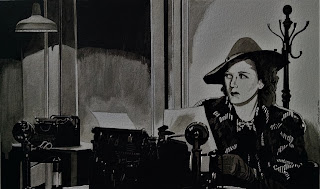LEGENDARY HEROES #14
JANE ARDEN
Created by writer Monte Barrett and artist Frank Ellis, Jane Arden was the original "girl reporter" and prototype for Lois Lane and Brenda Starr. The comic strip was distributed by the Register & Tribune Syndicate and debuted on November 26, 1928. Barrett wrote the stories until his death in 1949 when Walt graham took over the job. Illustrator Ellis left in 1935 and was replaced by Russell E. Ross who did the comic strip for most of its run. Jane Arden was the crime reporter of her big city newspaper and sought to infiltrate and expose criminal activity rather than merely report on it. The portrayal was a departure for women characters in the comic strips. When WWII broke out Barrett & Ross were quick to scrap their current storyline and rushed Jane Arden into the war zone, giving her an assignment in Europe to cover the war. The comic strip ended on January 20, 1968 after a 40-year run in the newspapers.
While "Jane Arden" was moderately successful in the United States it was highly popular in Canada and Australia. Jane Arden began appearing in comic books with reprints of her newspaper adventures in October 1937 in Feature Funnies which later became Feature Comics, until April 1940. Crack Comics carried Jane Arden from May 1940 - September 1942, and she got her own self-titled comic book in 1948 for two issues with St. John Publications. Jane Arden became a radio drama with Ruth Yorke in the role of the "fearless girl reporter, the most beautiful woman in the newspaper world". The radio series was first heard in June 1938 on WJZ in New York and then moved to the NBC Blue Network on September 26, 1938 where it was sponsored by Ward Baking. The 15-minute show aired weekdays at 10:15 a.m. The series ended on June 23, 1939. In 1939 Warner Brothers released a film adaptation of Jane Arden with Rosella Towne playing the spunky reporter. It was supposed to be the first in a series of films but subsequent movies never materialized.
In the 1920s comics were full of female strips that did not portray women as the equals of their male characters. "Tillie the Toiler" and "Winnie Winkle the Breadwinner" were secretaries and office workers, while others like "Dumb Dora" (yes, a comic strip was titled that), were strictly played for laughs in a male dominated world, and none of the women were the peers or contemporaries of their male counterparts. Except for Jane Arden. She wasn't some sob sister writing advice to the lovelorn, or dispensing proper etiquette in a daily column. She was the crime reporter of a big city newspaper where she not only succeeded, but dominated in the role. Perhaps a better testament to Jane Arden's cultural impact is that Pulitzer Prize-winning journalist Mary McGrory credits Jane Arden for inspiring her to become a newspaper writer.


.jpg)

.jpg)
Comments
Post a Comment